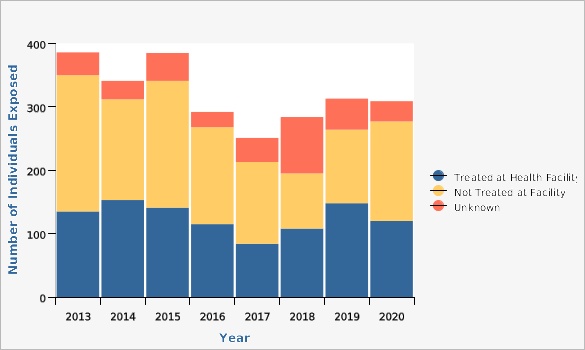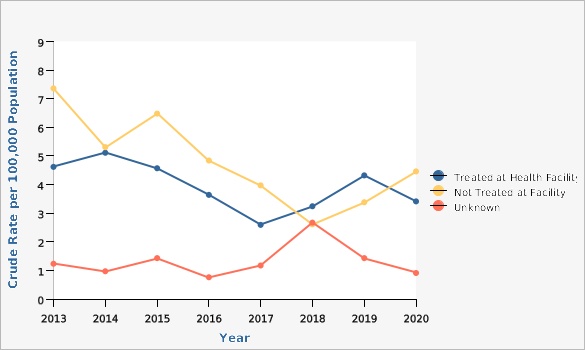Complete Health Indicator Report of Carbon Monoxide: Poison Control Exposures
Definition
Carbon monoxide (CO) is an odorless, colorless, poisonous gas that can cause sudden illness and death if inhaled.Numerator
Utah Poison Control Center (UPCC): Numbers of humans exposed to carbon monoxide Utah Behavioral Risk Factor Surveillance Survey (BRFSS): Number of households reporting at least one carbon monoxide detector in their house/current residenceDenominator
UPCC: Utah resident mid-year population estimates BRFSS: A weighted (by household) value that allows the estimate to be based on the total number of households in the stateData Interpretation Issues
Data from the Utah Poison Control Center (UPCC) may be missing Utah residents that were exposed to carbon monoxide (CO), but called another state's poison control center. The UPCC data include all calls in which actual or suspected human contact with CO was recorded. Exposed animals and out-of-state residents were excluded. Additionally, calls that were not exposure related (e.g. seeking CO education materials) were removed.Why Is This Important?
Carbon monoxide (CO) poisoning can happen quickly and without warning. This cause of poisoning or death is almost entirely preventable if proper measures are taken, such as always having a working carbon monoxide detector in your home or work. CO is found in combustion fumes such as those produced by cars and trucks, small gasoline engines, stoves, lanterns, burning charcoal and wood, gas ranges, and heating systems. Wherever there is a flame or combustion, deadly carbon monoxide gas can be produced. CO from these sources can build up in enclosed or semi-enclosed spaces making the air poisonous for people and animals. CO poisoning is particularly concerning after emergency situations because the emergency equipment used during power outages or nature disasters gives off CO. Generators, grills, camp stoves, gasoline equipment, propane, natural gas, or charcoal-burning devices should never be used inside a home, basement, garage, camper, or even outside near an open window. CO poisoning can also occur outdoors and has been reported while boating. In this case, CO poisoning is attributed mostly to generator exhaust that builds up inside and outside a boat in areas near exhaust vents. Dangerous concentrations of CO can accumulate within seconds; due to the possibility of rapid CO accumulation while boating, it is recommended that all boat owners schedule regular engine and exhaust system maintenance for their boats and install and test daily a battery operated CO detector. CO poisoning is almost entirely preventable. To protect yourself from CO poisoning, use equipment that emits CO responsibly and install a properly working CO detector in your home. These can be purchased at most grocery and home improvement stores for a relatively low cost. Additionally, it is crucial to check and maintain your CO detector including, but not limited to, changing batteries and checking its power source.Healthy People Objective EH-22.7:
Increase the number of States, Territories, Tribes, and the District of Columbia that monitor diseases or conditions that can be caused by exposure to environmental hazards: Carbon monoxide poisoningU.S. Target: 56 States, Territories, and the District of Columbia
What Is Being Done?
Organizations, such as the Centers for Disease Control and Prevention (CDC), offer free resources that provide information about CO poisoning and prevention. Also, health promotion and community outreach activities are available to educate the public about CO poisoning and prevention. However, it is primarily up to the individual to practice behaviors that prevent CO poisoning such as installing working CO detectors and using equipment that emits CO gas properly.Available Services
The [https://poisoncontrol.utah.edu/ Utah Poison Control Center] (UPCC) is a 24-hour resource for poison information, clinical toxicology consultation, and poison prevention education. This free and confidential service is available 365 days a year. For poison emergencies, questions, and prevention information call 1-800-222-1222.Related Indicators
Related Health Status Outcomes Indicators:
Graphical Data Views
Unintentional Carbon Monoxide Exposures: Number of Individuals Reported to Poison Control Center by Year and Treatment in a Healthcare Facility, Utah, 2013-2020

These data may be used to estimate the population's exposure to carbon monoxide (CO). They may also be used to estimate CO exposures among exposed persons who may not be treated in a healthcare facility. Not all potentially hazardous CO exposures will be captured by poison control center calls. If there are no acute symptoms from a moderately elevated exposure in the home, it will unlikely be recognized.
| Treated at Healthcare Facility | Year | Number of Individuals Exposed | ||||
|---|---|---|---|---|---|---|
Record Count: 24 | ||||||
| Treated at Health Facility | 2013 | 135 | ||||
| Treated at Health Facility | 2014 | 153 | ||||
| Treated at Health Facility | 2015 | 141 | ||||
| Treated at Health Facility | 2016 | 115 | ||||
| Treated at Health Facility | 2017 | 84 | ||||
| Treated at Health Facility | 2018 | 108 | ||||
| Treated at Health Facility | 2019 | 148 | ||||
| Treated at Health Facility | 2020 | 120 | ||||
| Not Treated at Facility | 2013 | 215 | ||||
| Not Treated at Facility | 2014 | 159 | ||||
| Not Treated at Facility | 2015 | 200 | ||||
| Not Treated at Facility | 2016 | 153 | ||||
| Not Treated at Facility | 2017 | 129 | ||||
| Not Treated at Facility | 2018 | 87 | ||||
| Not Treated at Facility | 2019 | 116 | ||||
| Not Treated at Facility | 2020 | 157 | ||||
| Unknown | 2013 | 36 | ||||
| Unknown | 2014 | 29 | ||||
| Unknown | 2015 | 44 | ||||
| Unknown | 2016 | 24 | ||||
| Unknown | 2017 | 38 | ||||
| Unknown | 2018 | 89 | ||||
| Unknown | 2019 | 49 | ||||
| Unknown | 2020 | 32 | ||||
Data Source
Utah Poison Control CenterUnintentional Carbon Monoxide Exposures: Number Reported to Poison Control Center (Crude Rate) by Year and Treatment in a Healthcare Facility, Utah, 2013-2020

This data may be used to estimate the population's exposure to carbon monoxide (CO) and to potentially monitor trends over time. They may also be used to estimate CO exposures among exposed persons who may not be treated in a healthcare facility. Not all potentially hazardous CO exposures will be captured by poison control center calls. If there are no acute symptoms from a moderately elevated exposure in the home, it will unlikely be recognized.
| Treated at Healthcare Facility | Year | Crude Rate per 100,000 Population | Lower Limit | Upper Limit | ||
|---|---|---|---|---|---|---|
Record Count: 24 | ||||||
| Treated at Health Facility | 2013 | 4.6 | 3.8 | 5.4 | ||
| Treated at Health Facility | 2014 | 5.1 | 4.3 | 5.9 | ||
| Treated at Health Facility | 2015 | 4.6 | 3.8 | 5.3 | ||
| Treated at Health Facility | 2016 | 3.6 | 3.0 | 4.3 | ||
| Treated at Health Facility | 2017 | 2.6 | 2.0 | 3.1 | ||
| Treated at Health Facility | 2018 | 3.2 | 2.6 | 3.8 | ||
| Treated at Health Facility | 2019 | 4.3 | 3.6 | 5.0 | ||
| Treated at Health Facility | 2020 | 3.4 | 2.8 | 4.0 | ||
| Not Treated at Facility | 2013 | 7.4 | 6.4 | 8.3 | ||
| Not Treated at Facility | 2014 | 5.3 | 4.5 | 6.1 | ||
| Not Treated at Facility | 2015 | 6.5 | 5.6 | 7.4 | ||
| Not Treated at Facility | 2016 | 4.8 | 4.1 | 5.6 | ||
| Not Treated at Facility | 2017 | 4.0 | 3.3 | 4.7 | ||
| Not Treated at Facility | 2018 | 2.6 | 2.1 | 3.2 | ||
| Not Treated at Facility | 2019 | 3.4 | 2.8 | 4.0 | ||
| Not Treated at Facility | 2020 | 4.5 | 3.8 | 5.2 | ||
| Unknown | 2013 | 1.2 | 0.8 | 1.6 | ||
| Unknown | 2014 | 1.0 | 0.6 | 1.3 | ||
| Unknown | 2015 | 1.4 | 1.0 | 1.8 | ||
| Unknown | 2016 | 0.8 | 0.5 | 1.1 | ||
| Unknown | 2017 | 1.2 | 0.8 | 1.5 | ||
| Unknown | 2018 | 2.7 | 2.1 | 3.2 | ||
| Unknown | 2019 | 1.4 | 1.0 | 1.8 | ||
| Unknown | 2020 | 0.9 | 0.6 | 1.2 | ||
Data Source
Utah Poison Control CenterUnintentional Carbon Monoxide Exposures: Number of Individuals Reported to Poison Control Center by Exposure Location, Utah, 2013-2015, 2016-2018

| 3 Year Groups (ending 2015, 2018) | CO Exposure Location | Number of Individuals Exposed | Note | |||
|---|---|---|---|---|---|---|
Record Count: 12 | ||||||
| 13-15 | Residential | 848 | ||||
| 13-15 | Public Area | 34 | ||||
| 13-15 | School | 30 | ||||
| 13-15 | Workplace | 131 | ||||
| 13-15 | Other | 44 | ||||
| 13-15 | Unknown | 25 | ||||
| 16-18 | Residential | 645 | ||||
| 16-18 | Public Area | 24 | ||||
| 16-18 | School | 73 | ||||
| 16-18 | Workplace | 43 | ||||
| 16-18 | Other | 38 | ||||
| 16-18 | Unknown | 4 | * | |||
Data Notes
^ ^*Use caution in interpreting, the estimate has a coefficient of variation >30% and is therefore deemed unreliable by Utah Department of Health standards. '''The sites of exposure are defined as the following:''' Residential: Patient's own home/domicile or that of someone other than the patient. Public Area: Any park, theater, public event center, or other public site that is not a restaurant or other food preparation service. School: Any school, child care center, college, university, classroom, schoolyard, dormitory, or school-sponsored activity. Workplace: Any shop, building, office, or non-residential room where the patient is employed. Other: Any site not specifically defined previously. This includes ambulance, rescue squad car, chronic care residential facility, correctional facility, detox center, or nursing home.Data Source
Utah Poison Control CenterReferences and Community Resources
Utah Environmental Epidemiology Program - Carbon Monoxide[[br]] [http://www.health.utah.gov/utahair/pollutants/CO/][[br]] [[br]] Utah Division of Air Quality - Air Pollutants: Carbon Monoxide[[br]] [https://deq.utah.gov/air-quality/carbon-monoxide][[br]] [[br]] Centers for Disease Control and Prevention - Carbon Monoxide Poisoning[[br]] [http://www.cdc.gov/co/default.htm][[br]] [[br]] U.S. Environmental Protection Agency - An Introduction to Indoor Air Quality (IAQ): Carbon Monoxide (CO)[[br]] [http://www.epa.gov/iaq/co.html]More Resources and Links
Evidence-based community health improvement ideas and interventions may be found at the following sites:- Centers for Disease Control and Prevention (CDC) WONDER Database, a system for disseminating public health data and information.
- United States Census Bureau data dashboard.
- Utah healthy Places Index, evidence-based and peer-reviewed tool, supports efforts to prioritize equitable community investments, develop critical programs and policies across the state, and much more.
- County Health Rankings
- Kaiser Family Foundation's StateHealthFacts.org
- Medical literature can be queried at PubMed library.
Page Content Updated On 01/18/2022,
Published on 02/18/2022
